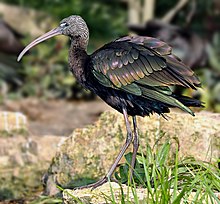Plegadis falcinellus
| Glossy ibis | |
|---|---|
 |
|
| Non-breeding plumage | |
| Scientific classification | |
| Kingdom: | Animalia |
| Phylum: | Chordata |
| Class: | Aves |
| Order: | Pelecaniformes |
| Family: | Threskiornithidae |
| Genus: | Plegadis |
| Species: | P. falcinellus |
| Binomial name | |
|
Plegadis falcinellus Linnaeus, 1766 |
|
The glossy ibis (Plegadis falcinellus) is a wading bird in the ibis family Threskiornithidae. The scientific name derives from Ancient Greek plegados and Latin, falcis, both meaning "sickle" and referring to the distinctive shape of the bill.
This is the most widespread ibis species, breeding in scattered sites in warm regions of Europe, Asia, Africa, Australia, and the Atlantic and Caribbean regions of the Americas. It is thought to have originated in the Old World and spread naturally from Africa to northern South America in the 19th century, from where it spread to North America. The glossy ibis was first found in the New World in 1817 (New Jersey). Audubon saw the species just once in Florida in 1832. It expanded its range substantially northwards in the 1940s and to the west in the 1980s. This species is migratory; most European birds winter in Africa, and in North America birds from north of the Carolinas winter farther south. Birds from other populations may disperse widely outside the breeding season. While generally declining in Europe, it has recently established a breeding colony in southern Spain, and there appears to be a growing trend for the Spanish birds to winter in Britain and Ireland, with at least 22 sightings in 2010. In 2014, a pair attempted to breed in Lincolnshire, the first such attempt in Britain A few birds now summer in Ireland, but as yet there is no evidence of breeding there.
Glossy ibises undertake dispersal movements after breeding and are very nomadic. The more northerly populations are fully migratory and travel on a broad front, for example across the Sahara Desert. Populations in temperate regions breed during the local spring, while tropical populations nest to coincide with the rainy season. Nesting is often in mixed-species colonies. When not nesting, flocks of over 100 individuals may occur on migration, and during the winter or dry seasons the species is usually found foraging in small flocks. Glossy ibises often roost communally at night in large flocks, with other species, occasionally in trees which can be some distance from wetland feeding areas.
...
Wikipedia

